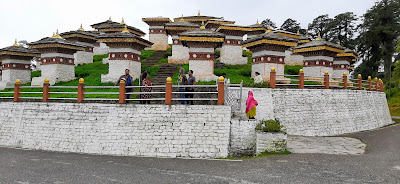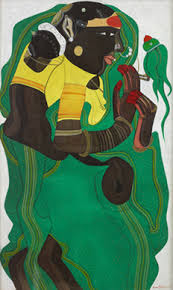Early morning I went out for a
walk in the heart of Thimphu. The
streets were rather deserted. I felt like a fish in water! How lucky that I
didn't have to steer clear of joggers and other health-freaks! While in Trivandrum, morning walk was a daily
routine but more often than not, I would drop the idea just because some
brisk-walker would invariably bump into me at the Museum grounds. In Bhutan, things
were different. The air was so crystalline, low altitude clouds floating
between hills, well-kept foot-paths with an array of flowering plants by their
sides…
Joyously walking ahead, I
could see the worker settlements, all temporary structures situated right
opposite to the high-profile Information& Broadcasting Ministry offices.
Nobody considered them as an eye-sore. Half a dozen families were happily
living there amidst the imposing buildings around. In fact, rules permitted
only ground plus five floors in Bhutan and no building was imposing for sure!
While returning, I could see
the refreshing sight of a tree being spared at the middle of a road! They didn’t
cut the tree to make way for the thoroughfare, preserved it instead, though the
forest cover in Bhutan was 71%.
We made a visit to the Royal
Textile Academy before moving on to Dochula
Pass. The Academy was started in 2001 at the initiative of the third Queen
through a $165,000 Danish funding (DANIDA). Denmark has been a liberal donor to
Bhutan and their total aid to this Himalayan country for the past 25 years equals
$ 0.255 billion. However, that doesn’t hold a candle before the Indian
contribution which has been the largest among foreign aid. The budget
allocation for Bhutan is Rs.2802 crore last year (2019). Interestingly,
traditional recipients like Bhutan, Nepal and Bangladesh have been superseded
by new entrants like Afghanistan, Maldives and East African countries for the
past nine years or so.
We visited the hand-weaving
section of the RTA and found the all-women workforce fully immersed in their
work. They didn’t have either the time or the inclination to look up and smile.
Some of them had brought their children along who hid behind their mothers when
we tried to be friendly!
There are some textile items,
casuals mostly, for sale at the RTA but my advice to you is to wait! The
handicrafts bazar is just across the street where you get everything, authentic
and moderately priced, at a bargain.
 |
| Nandu, my son shows-off the desi dress while his mother Moly beams with pride! |
We bid adieu to Thimphu and the new destination Punakha
was 70 km away. In between, arguably the most scenic spot of Bhutan – Dochula Pass – lay at an altitude of
3160 m. The weather is usually foggy and chilly; clothing in light woollen
stuff is strongly recommended. During the tourist season September to November,
one could do away with thermal wear anywhere in Bhutan. We were there in the
beginning of September and the rains were sporadically making its presence
felt! Luckily it didn’t act as a spoiler. In my opinion, October would be ideal
to visit Bhutan as the weather is extremely clear. You could get a 360 degree panoramic
view of the snow-covered peaks of the Himalayan range from Dochula Pass during the period October to February. The highest mountain
- Gangkar Puensum with an altitude
7158 m. is most revered.
Dochula
Pass
is the place where the Bhutanese celebrate their New Year, Losar with all gusto every February. The remnants of the event were
still there to be seen, the flags et al.
In fact Dochula Pass is a war memorial, in honour of the sixteen Bhutanese
soldiers who were killed in the 2003 battle, Operation All Clear. The action spanning 19 days was led by none
other than the (fourth) King – Jigme
Singye Wangchuk – against Assamese
insurgents from India. The rebels were operating from Bhutan in order to raid
the Indian territories in Assam. The King and his men dislodged the rebels from
their thirty odd hideouts. As a befitting salute, the first Queen built the
memorial next year to mark the victory of her husband.
 |
| Reach out and touch the clouds! |
The memorial consists of 108 chortens (stupas) in
three layers. They are arranged in multiples of nine, i.e., 9 x 3 = 27 for the
top layer, 9 x 4 = 36 for the middle and 9 x 5 = 45 for the bottom. As you are
aware, these numbers are auspicious under oriental numerology. Karma, our guide
came up with a totally different point of view. According to him, 108 stands
for the unification of Jeevatma (individual
self) with Paramatma (the Ancient
One). The number ‘1’ stands for self, “0” is for Love and ‘8’ represents
Infinity.
 |
| 108 Chortens at the Dochula Pass |
One more explanation is
possible, which is much easier to grasp.
God is Love!
Karma is right in both ways! Our
knowledge about things is hopelessly inadequate!
After spending some time
walking clockwise around the chortens,
we quietly made a retreat. There was a nice restaurant at the Pass where you could refresh yourself
before proceeding to Punakha Dzong.
Like Lakhangs (temples), Dzongs
(Forts) are ubiquitous in Bhutan. Major Dzongs
have their own Lakhangs inside where
invaluable treasures are kept in custom-made chests. The mantras and prayer-wheels
act as firewalls!
Punakha
Dzong is the second oldest and second largest fort in Bhutan.
Located between the Pho Chhu (male)
and Mo Chhu (female) rivers in the Punakha Valley and lined with Jacaranda
trees around, the Dzong is an
unbelievably beautiful sight.
 |
| Punakha Dzong |
Construction of the fort
started in 1637 and it took only one year to complete the work. Even the Design
itself was Dream Aided, one must say, as the architect Zowe Palep had a vision in his dream enabling him to conceive the
plan without the help of the drawing-board!
The measurements of the Dzong are 180 m x 72 m x 18 m with three
court-yards in a row.
The steep wooden entry stairs
are designed to be pulled up and the heavy wooden door at the entrance is still
closed at night. A covered wooden cantilever bridge crossing the Mo Chhu River was built in seventeenth
century but was washed away in subsequent floods. (A new bridge in the same
traditional style was built in 2008).
The first courtyard is the
administrative block with a massive whitewashed stupa near an equally massive Bodhi tree and complete with a Naga temple. Punakha Dzong was the administrative HQ of Government of Bhutan
until 1955. The Naga temple at the first
courtyard houses the original holy book of the Drukpa School of Thought. The deity Nag Yul Bum is believed to be perpetually guarding the golden
text! The second courtyard was earmarked as the residential quarters for monks.
The third one at the southernmost side was most important as the hall on its
right contained the sacred remains of Pema
Lingpa and Ngawang Namgyal.
Pema
(Padma) Lingpa (1450 – 1521) is second only to Padmasambhava in the hierarchy of Gurus. Namgyal (1594 – 1651) popularly known as the Bearded Lama is not exactly a Guru, but the unifier of Bhutan who came
from Tibet. The caskets containing the sacred remains of the two are not opened
at all and nobody is allowed inside the hall. When a new King assumes charge,
he goes inside and takes the blessings of the two holy men before coronation.
The southernmost part of the Dzong is the temple where massive gold
statues of the Buddha, Guru Rinpoche
(Padmasambhava) and other Zhabdrungs (great gurus) greet you with
their benign smiles. The national
treasures are kept somewhere near and the visitors are forbidden to enter
beyond the location of the statues.
There are around 200 murals in
the entire Punakha Dzong and they
look brighter after the restoration work done in 2008. The life of Buddha is
depicted inside the temple but the accent is on miracles. In fact, Gautama Buddha led a life of infinite
compassion leaving no space for executing miracles. He underplayed his siddhis (supranormal powers associated with
planes of Consciousness) and always advised his followers to concentrate
more on his teachings. The miracle that he performed at Shravasti couldn’t be generalised as it was done on a challenge. Oddly
enough, the people we met in Bhutan seem to be believing mainly in externals! They
are harbouring deep faith in religious rites and reincarnations. Interestingly,
Buddhism was originated as a deviation against implanted rigidities of Hinduism
during Siddhartha Gautama’s times. In
my humble opinion, the essence of Buddha’s teachings is the practice of
Selflessness and the cultivation of Love. In other words, the focus is on spirituality
and not on religion.
(contd.)
*******
